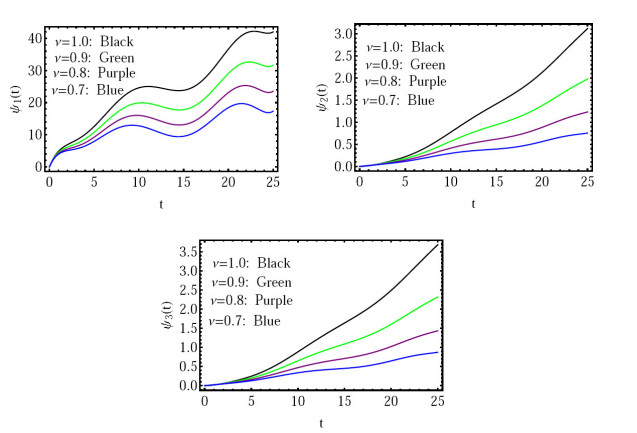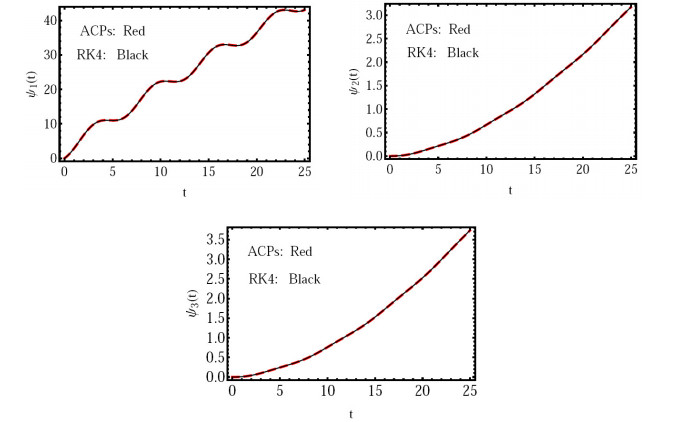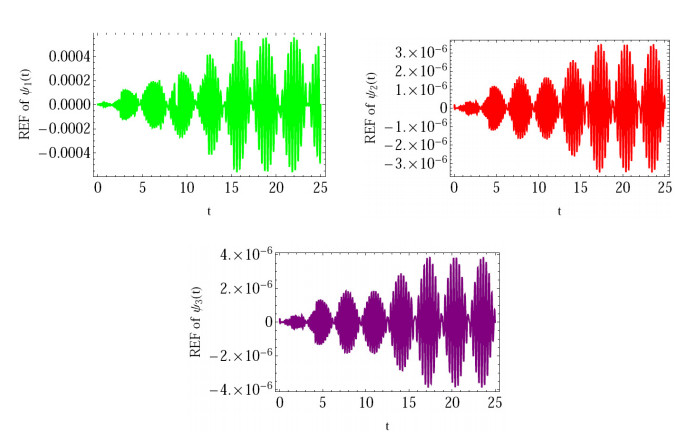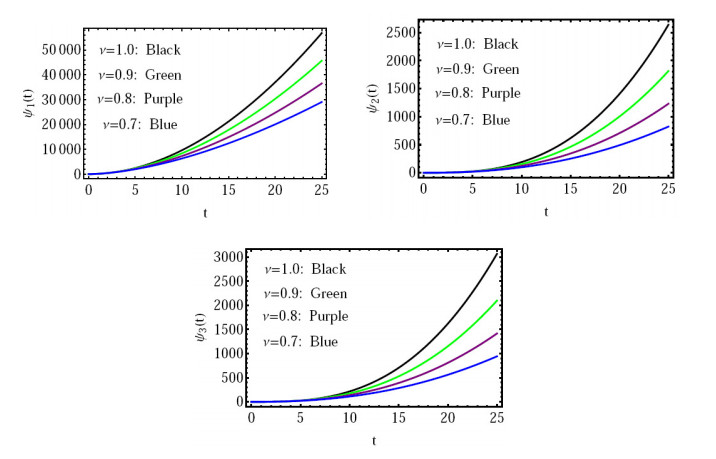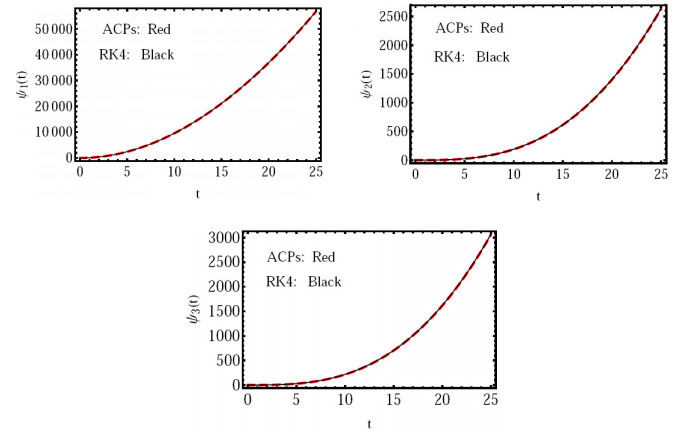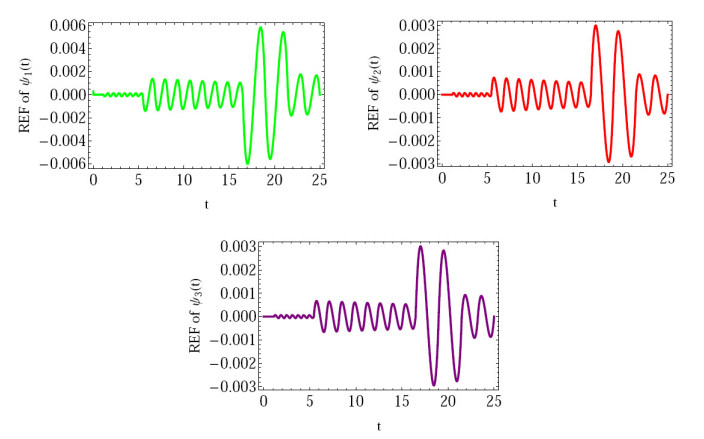1.
Introduction
The model's purpose is to explain the contaminant levels in a system that consists of three lakes [1,2], as shown in Figure 1. With interconnected channels acting as pipelines with specific flow directions between the compartments, each lake is thought of as a sizable compartment. The first lake receives a pollutant at a specific rate that may be changed or constant over time. We want to know how polluted each lake is at any given time. The water volume in any of the three lakes is assumed to be constant and each lake's contaminant is evenly distributed across the lake by some sort of mixing procedure, as we assumed. Additionally, the pollution is constant and does not change into other forms.
We shall take into account the periodic and linear input models for the pollution source. The input model with periodic has not, as far as the authors are aware, been mentioned in any published works as possible behaviors for the pollution source.
A field of mathematics known as fractional analyzers have the ability to represent and analyze a wide range of real-world situations [3,4]. Fractional-order analysis has drawn increasing interest in the study of biological models, where such complex systems are regularly explained empirically by the scaling power law of fractional order. The system's three connected lakes' pollution model by waterways uses one of these mathematical equations. There are many research papers that studied this important model [5,6,7].
For recent developments based on the collocation approach, this article presents the first use of the Appell type Changhee polynomials (ACPs) based spectral collocation approach to solve fractional-order pollution models for a system of three lakes connected by waterways. When the approach is applied, the set of differential equations is converted into a system of algebraic equations. The approximate solution for the original equation is found by solving this system, which produces the unknown coefficients of the series solution. The spectral collocation method (SCM) has some advantages for handling this class of problems in which the Appell-type Changhee coefficients for the solution can exist very easily after using the numerical programs. For this reason, this method is much faster than the other methods [8,9]. They are widely used because of their good properties in the approximation of functions. Also, this method is a numerical technique with high accuracy and fast convergence and it is easy to use in finite and infinite domains for different problems. In addition, the domain discretization and approximation of the nonlinear terms are not necessary for this method, which is an important advantage.
The reader may find it helpful to understand the mathematical modeling process by reading through many significant studies, such as the one on the mathematical model of internal atmospheric waves, also referred to as gravity waves, which occur inside a fluid rather than on the surface [10]; time-fractional (2+1)-dimensional Wu-Zhang nonlinear system of partial differential equations describing a long dispersive wave [11]; how nonlinear time-fractional diffusion equations are thought to describe oil pollution in the water [12] and nine-dimensional chaos for the fractional (Caputo-sense) Lorenz system [13].
In this study, we will use the ACPs for the first time to develop an approximation of the fractional derivative formula and use it to solve the fractional pollution model of three lakes by using the SCM.
The rest of the paper is organized as follows: In section two, we present some definitions and concepts concerning fractional derivatives, the Appell-type Changhee polynomials and other related ideas. In section three, we give an approximate formula for the fractional derivatives by using the ACPs. Section four is devoted to presenting an explanation of the pollution model of three lakes and its formulation. Through section five, we give the implementation of the proposed method. In section six, we present a numerical simulation of the proposed model under study. Finally, the conclusions are in section seven.
2.
Preliminaries
2.1. Integral and derivative of fractional order
Fractional-order operators have numerous definitions in the literature [14,15]. The two most important fractional derivatives used in the development of fractional calculus theory are defined below.
Definition 2.1. The Riemann-Liouville fractional integral Iν of order ν, for the function ψ(t) is defined as follows [14,15]:
where Γ(t)=∫∞0zt−1e−zdz is the Gamma function.
Definition 2.2. The Riemann-Liouville fractional derivative RLDν of order ν, of the function ψ(t) is defined as follows [14,15]:
These formulations have several limitations when simulating some real-world problems [14,15]. The Liouville-Caputo formulation, however, was designed to address these problems. As stated in the definition that follows, we use it.
Definition 2.3. The fractional derivative in the Liouville-Caputo sense Dν of ψ(t) is given as
The Liouville-Caputo fractional derivative Dν possesses that
and
where ⌈ν⌉ is the ceil function. Also,
2.2. The Changhee polynomials and other related ideas
Changhee polynomials Chm(t) and Changhee numbers Chm are defined by [16,17]:
where Chm=Chm(0) are the Changhee numbers [16]. The ACPs of degree m are defined by
From (2.7), we get
From (2.8), we have
and Ch∗0=1 and 2Ch∗m+mCh∗m−1=0,∀m≥1.
Any function u(t)∈L2[0,1] can be approximated (and denoted by u∗(t)) as a finite series sum of the form
3.
Approximation formula of Dν using ACPs
Now, we give the following theorem to derive an approximate formula of the fractional derivative Dν for the function u∗(t) given in (2.10).
Theorem 3.1. For u∗(t) given in (2.10), the Caputo derivative of order ν>0 can be approximated by
where Ch∗i−j is the Changhee number and κi,j,ν is given by
Proof. By taking Ch∗i(t) of degree i, where i=0,1,…,m, from (2.4) and (2.10) we have
where κi,j,ν is given in (3.1), and the proof is finished. □
4.
Some concepts about the pollution problem
4.1. An explanation of the pollution model
A group of lakes connected by channels is referred to as a system of lakes. Models of these lakes consist of sizable segments connected by pipelines [18]. Three lakes are shown in a system in Figure 1. A pollutant is delivered into only one of the lakes (in this case, lake one) with rate b at time t=0; for instance, from a factory b(t), then as shown by the arrows, the contaminated water enters the other lakes via the pipes or channels [19]. We also assume that the pollution is distributed equally throughout all of the lakes and that in each lake the volume of water stays constant. Predicting the amount of contamination in each lake is our goal for t≥0 using these assumptions.
Let Vk and ψk(t),k=1,2,3 symbolize the water volume and pollutant count in lake k, respectively, to describe the dynamic behavior of the system. The concentration of the pollutant in the lake k at time t is then given by
The following equation describes the pollution flux rik(t) flowing from the lake k into i during time t. When we further assume that the flow rate Fik between lakes k and i is constant, the following results follow:
As a result, the pollutant rate in lake k flows into lake i at time t and is represented by the expression rik(t).
By applying the subsequent idea to every lake (i=1,2,3):
we obtain that
The initial conditions for (4.4) are
The rate of entering flow is equal to the rate of outgoing flow for each lake because the amount of water in each lake remains constant for time t≥0. As a result, the following flow rate circumstances arise:
4.2. Fractional case of the pollution model
In this part, we provide a revised version of the pollution model in the sense that the Liouville-Caputo fractional derivative is taken into consideration in the current study to better understand both the qualitative analysis and the numerical iterative analysis of the proposed model. It is described as follows [20]:
with
Using this model (4.7)–(4.10) in its fractional version [21], we may more clearly assess the water volume and pollutant count in each lake of the system in the future and the past, thanks to the memory effect of fractional derivatives. While mathematical models with integer derivatives are crucial for understanding the dynamics of such systems, they have certain limits because these systems lack memory or nonlocal effects and, hence, these models in their current state are not always appropriate. As a result, to effectively examine various natural phenomena, it is important to convert several pollution models into fractional differential equations (FDEs). FDEs are extensively used in the study of unusual events in nature and the theory of complex systems in general, and they take into account the curves characteristics to a large extent. Finally, it can explain temporal delays, fractal features, and other phenomena. In addition, we can control the rate of pollutant transmission between the three lakes.
5.
Numerical implementation
In this part, we lay out how the suggested strategy that would be applied to simulate the fractional-order form of the model (4.7)–(4.10). This aim will be achieved through the following steps.
(1) Let us express and approximate the solution ψγ(t),γ=1,2,3 as a finite series form in terms of the ACPs and denoted by Ψγ,m(t),γ=1,2,3 as follows:
(2) Upon substituting from (5.1) into the system (4.7)–(4.9), we get
(3) By collocation the above system (5.2)–(5.4) at m−1 of points tr=rm−1+1,r=1,2,⋯,m−1, this reduces them to a linear system of algebraic equations in the coefficients cγ,i,γ=1,2,3,i=0,1,...,m.
(4) Also, by substituting from Eq (5.1) into the initial conditions (4.10), then (4.10) will be reduced also to algebraic equations in the coefficients cγ,i:
(5) We now use the successive over-relaxation algorithm to solve numerically the linear system (5.2)–(5.5) for the unknowns cγ,i,γ=1,2,3,i=0,1,⋯,m. This, in turn, will lead us to compute the approximate solution by substitution in the form (5.1).
6.
Numerical experimentations
Now, we proceed to check the quality of the scheme by checking some numerical simulations on two examples in the interval [0,25] for the system (4.7)–(4.10) for different two pollution models. Howevwer, in all figures, we take the same values of the following parameters [22]:
Now, we are going to study the following two input models [20]. In each case, we will compare the obtained solutions with the fourth-order Runge-Kutta method (RK4). We also evaluate the residual error function (REF) [23] to check the accuracy and quality of the proposed scheme.
Case 1: Periodic input model
When the pollutant is intermittently delivered into lake one, this input model is employed. Here's an illustration:
where α represents the average pollutant input concentration, β is the size of fluctuations and ω is the fluctuations's frequency. Let α=β=2,ω=1, with the same values of the parameters given in (6.1) and the initial conditions. Figures 2–4 represent the results for this studied case.
(1) In Figure 2: The solution for ν=1.0,0.9,0.8,0.7, for m=4.
(2) In Figure 3: Analysis of the solution in comparison to the RK4 solutions at (ν=1) for m=5.
(3) In Figure 4: We compute and plot the REF at ν=0.96.
Case 2: Linear input model
When a linear concentration of the pollutant is injected into the first lake, this input model is utilized. As an example, we take b(t)=λt, where the positive constant λ=200, take the zero initial conditions and the values of the parameters given in (6.1). Figures 5–7 represent the results for this studied case.
(1) In Figure 5: The solution for ν=1.0,0.9,0.8,0.7, for m=4.
(2) In Figure 6: Analysis of the solution in comparison to the RK4 solutions at (ν=1) for m=5.
(3) In Figure 7: We compute and plot the REF at ν=0.96.
These results show that the suggested method is suitable for the fractional-order Liouville-Caputo fractional derivative solution for the given model. The values of ν,m determine how the numerical solution produced using the suggested approach behaves. The suggested approach also considerably improves the method's efficacy and outcomes.
Through the results that we obtained, especially in Figures 2 and 5 as well as in light of the geometric diagram for the placement of these three lakes, and based on the direction of the arrows that show the path of movement and transfer of pollution among the three lakes, we find that these results are consistent with the natural behavior of pollution in the lakes. This indicates that these solutions are closer to the actual and real solutions and, therefore, we confirm the efficiency of the method proposed here.
In addition through Table 1, we provide a comparison between the obtained approximate solution by the current method (ψi−ACPs(t), i=1,2,3) with the variational iteration method (VIM) [1] (ψi−VIM(t)) where we computed the REF at ν=0.97 with different values of the approximation-order m to estimate the effectiveness and precision of the provided approach. We take the same initial conditions and the same values of the parameters mentioned above. The given results of the errors in this table provide more confirmation of the efficiency and effectiveness of the proposed method than other methods.
7.
Conclusions
The target of this work was to analyze the dynamical behavior of the system of lakes pollution model utilizing the Liouville-Caputo fractional derivative operator and fractional calculus tools and methods. The mathematical model under inquiry was solved with various values of ν and m, as well as by computing the REF. We have established that the suggested method is surprisingly successful in studying this mathematical model. Additionally, by adding more terms from the approximation solution series, or by raising m, we can regulate the precision of the error and lower it. Also, we concluded that the mathematical model under consideration in this research is better suited for numerical simulations using the Liouville-Caputo fractional derivative operator. The findings obtained graphically and those acquired by utilizing the RK4 approach are comparable. Our findings also demonstrate the proposed method's accuracy and computational effectiveness. In addition, we compared the solution obtained by the proposed method with the variational iteration method where we computed the REF with different values of the approximation-order m to estimate the effectiveness and precision of the provided approach. These results show that the present method is very effective and thorough. As a generalization of the current work, we intend to use the same model in future research but with different types of polynomials or fractional derivatives. In addition, we will study this model as an optimization problem to help us in controlling it. Finally, we must point out that the Mathematica software program was used to carry out the numerical simulation work.
Use of AI tools declaration
The authors declare they have not used Artificial Intelligence (AI) tools in the creation of this article.
Acknowledgments
The researchers wish to extend their sincere gratitude to the Deanship of Scientific Research at the Islamic University of Madinah for the support provided to the Post-Publishing Program.
Conflict of interest
There are no competing interests declared by the authors.









 DownLoad:
DownLoad:

